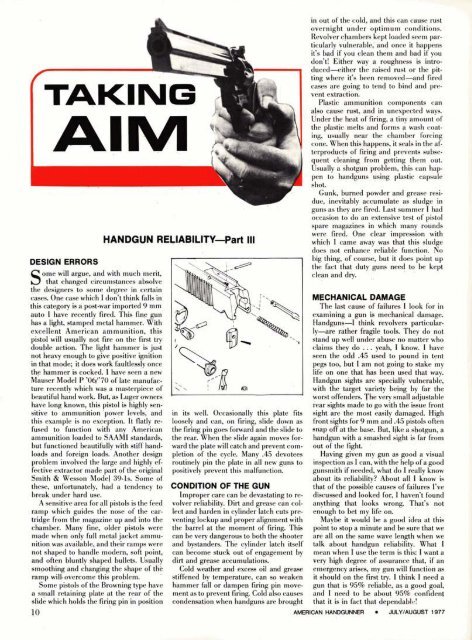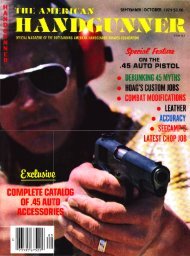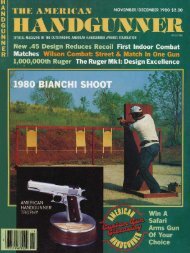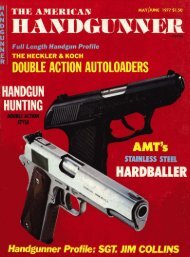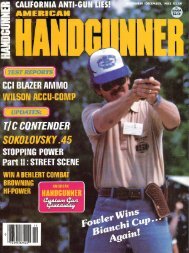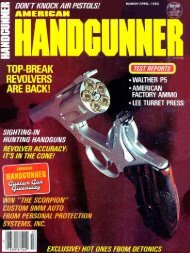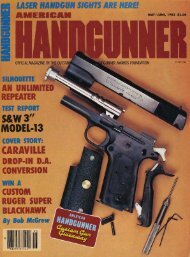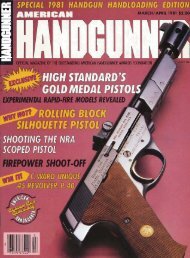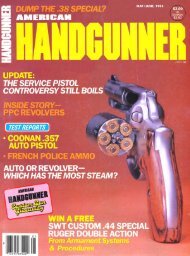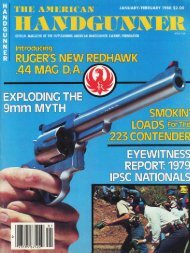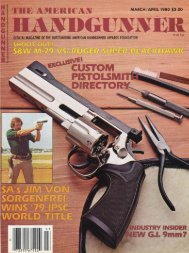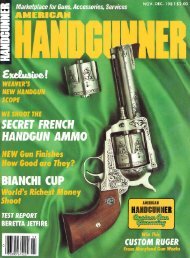American Handgunner July/August 1977
American Handgunner July/August 1977
American Handgunner July/August 1977
Create successful ePaper yourself
Turn your PDF publications into a flip-book with our unique Google optimized e-Paper software.
.- . . , .. , - ..DESIGNsERRORSome will argue, and with much merit,that changed circumstances absolvethe designers to some degree in certaincases. One case which I don't think falls inthis category is a post-war imported 9 mmauto I have recently fired. This fine gunhas a light, stamped metal hammer. Withexcellent <strong>American</strong> ammunition, thispistol will usually not fire on the first trydouble action. The light hammer is justnot heavy enough to give positive ignitionin that mode; it does work faultlessly oncethe hammer is cocked. I have seen a newMauser Model P '061'70 of late manufacturerecently which was a masterpiece ofbeautiful hand work. But, as Luger ownershave long known, this pistol is highly sensitiveto ammunition power levels, andthis example is no exception. It flatly refusedto function with any <strong>American</strong>ammunition loaded to SAAMI standards,but functioned beautifully with stiff handloadsand foreign loads. Another designproblem involved the large and highly effectiveextractor made part of the originalSmith & Wesson Model 39-1s. Some ofthese, unfortunately, had a tendency tobreak under hard use.A sensitive area for all pistols is the feedramp which guides the nose of the cartridgefrom the magazine up and into thechamber. Many fine, older pistols weremade when only full metal jacket ammunitionwas available, and their ramps werenot shaped to handle modern, soft point,and often bluntly shaped bullets. Usuallysmoothing and changing the shape of theramp will- overcome this problem.Some pistols of the Browning type havea small retaining plate at the rear of theslide which holds the firyg pin in position10HANDGUN RELIABILITY-PartIllin its well. Occasionally this plate fitsloosely and can, on firing, slide down asthe firing pin goes forward and the slide tothe rear. When the slide again moves forwardthe plate will catch and prevent completionof the cycle. Many .45 devoteesroutinely pin the plate in all new guns topositively prevent this malfunction.CONDITION OF THE GUNImproper care can be devastating to revolverreliability. Dirt and grease can collectand harden in cylinder latch cuts preventinglockup and proper alignment withthe barrel at the moment of firing. Thiscan be very dangerous to both the shooterand bystanders. The cylinder latch itselfcan become stuck out of engagement bydirt and crease accumulations.",Cold weather and excess oil and greasestiffened by temperature, can so weakenhammer fall or dampen firing pin movem.entas to prevent firing. Cold also causescondensation when handguns are broughtin out of the cold, and this can cause rustovernight under optimum conditions.Revolver chambers kept loaded seem particularlyvulnerable,' and once it happensit's bad if you clean them and bad if youdon't! Either way a roughness is introduced-eitherthe raised rust or the pittingwhere it's been removed-nd firedcases are going to tend to bind and preventextraction.Plastic ammunition components canalso cause rust, and in unexpected ways.Under the heat of firing, a tiny amount ofthe plastic melts and forms a wash coating,usually near the chamber forcingcone. When this happens, it seals in the afterproducpof firing and prevents subsequentcleaning from getting them out.Usually a shotgun problem, this can hapiento handguns using plastic capsulejhot.Gunk, burned powder and grease residue,inevitably accumulate as sludge inguns as they are fired. Last summer I hadoccasion to do an extensive test of pistolspare magazines in which many roundswere fired. One clear impression withwhich I came away was that this sludgedoes not enhance reliable function. Nobig thing, of course, but it does point upthe fact that duty guns need to be keptclean and dry.MECHANICAL DAMAGEThe last cause of failures I look for inexamining a gun is mechanical damage.Handguns-Ithink revolvers particular-ly-are rather fragile tools. They do notstand up well under abuse no' matter whoclaims they do . . . yeah, I know. I haveseen the odd .45 used to pound ip tentpegs too, but I am not going to stake mylife on one that has been used that way.Handgun sights are specially vulnerable,with the target variety being by far theworst offenders. The very small adjustablerear sights made to go with the issue frontsight are the most easily damaged. Highfront sights for 9 mm and .45 pistols oftensnap pff at the base. But,'like a shotgun, ahandgun with a smashed sight is far fromout of the fightHaving given my gun as good a v'isualinspection as I can, with the help of a goodgunsmith if needed, what do I really knowabout its reliability? About all I know isthat of the possible causes of failures 'I'vediscussed and looked for, I haven't foundanything that looks wrong. That's notenough to bet my life on.Maybe it would be a good idea at this~oint to ston a minute and be sure that weare all on the same wave length when wetalk about handgun reliability. What Imean when I use the term is this: I want avery high degree of assurance that, if anemergency arises, my gun will function asit should on the first try. I think I need agun that is 95% reliable, as a good goal,and I need to be about 95% confidentthat it is in fact that dependable!AMERICAN HANDGUNNER 0 JULY/AUGUST <strong>1977</strong>


